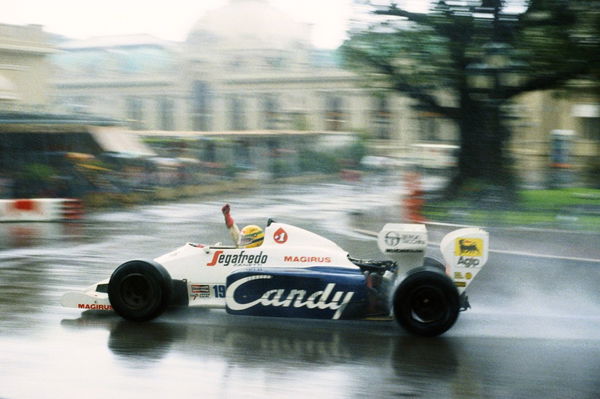
via Imago
3190987GI_F67642809

via Imago
3190987GI_F67642809
Formula One is a resource driven sport. So the top positions are always taken up by the so called “front runner” teams. Meanwhile those at the back of the grid squabble amongst themselves. They are usually too busy surviving that they have little opportunity of moving up the grid. But the uncertain character of racing means every now and then the sport throws a few surprises. This article combines a list of such surprises when backmarker triumphs made us root for the underdog.
10 Backmarker Triumphs
 10. Takuma Sato Super Aguri 2007 Canada
10. Takuma Sato Super Aguri 2007 Canada

ADVERTISEMENT
Article continues below this ad
The 2007 Canadian Grand Prix is remembered for two big reasons. First for Hamilton’s maiden F1 win and second for Kubica’s violent crash during the race.
Eagle-eyed fans will remember it for one more nifty detail. That detail was Takuma Sato’s 6th place finish. The Japanese driver scored 3 points driving the perennial backmarker Super Aguri. He battled and overtook Fernando Alonso’s McLaren on lap 67 of the 70 lap race on his way to P6!
The race itself was chaotic and crash riddled. Sato found himself in contention for points after making the right strategy calls. All this was despite starting the race from P14. The Japanese driver survived four safety car periods battled with Ralf Schumacher and Alonso. Ultimately, he prevailed to find himself in the backmarker triumphs list.

9. Pascal Wehrlein Manor 2016 Austria
Both Pascal Wehrlein and Manor had a great start to the year in 2016. Both the driver and the team were facing tough times at the end of the year. The German’s point scoring run in Austria was not mere luck. Incredible performance on both Saturday and Sunday proved.
In qualifying Wehrlein took his Manor to Q2. On rare occasions, the car moved past the Q1 and whenever it did it was Wehrlein at the helm. In Austria the German qualified in P12.
Wehrlein’s race in Austria got off to a less-than-stellar start when he lined up in the wrong grid slot. Felipe Massa was the original occupant but was sent to the pitlane. The 21-year-old quickly reversed back to his correct spot in 12th. Nothing in the rules forbade this and he managed to get his car stopped before the starting lights came on. This was crucial, as any car moving during the red light period would have been given a penalty.
From there Wehrlein delivered a strong race performance. He recovered from last to tenth during the second half. The German made his only pitstop just before the safety car came out.
Over the course of the race, Wehrlein executed his one stop brilliantly. He took his car upto P11 before the Force India of Sergio Perez retired elevating him to P10. It was of Manor’s final backmarker triumphs and a crucial one.

8. Jules Bianchi Marussia 2014 Monaco
The memory of Jules Bianchi serves as a reminder that Formula One and racing in general will always be dangerous. No matter the advancements in safety standards, there will always be room for improvement. Its painful how we lost the ever smiling Frenchman. But the right way to remember Jules is by the measure of his good drives. Admitted they are few but that’s down to the machinery he was driving for his short F1 career.
Even in this short time he showed he had what it takes. The Monaco 2014 GP stands as the watermark of his entire racing career.
The result was all the more remarkable given that he had a gearbox penalty. The day got worse as he was punished for starting in the wrong grid position. Lotus’ Pastor Maldonado failed to get away on the formation lap, which led to the confusion.
The resultant five second stop/go penalty would continue to hang over the Frenchman even after he had crossed the line. He had served it alright, butt the Safety Car had been deployed at the time. So eighth became ninth in the final classification.
Ninth may not be spectacular but it actually is given he started P19 but climbed to P10 by lap 59. In the end the two points he scored went a long way in ensuring the team’s survival. This was one of the backmarker triumphs that showed the world what a great lost talent he was.

7. Sebastian Vettel Scuderia Toro Rosso 2008 Italy
Driving for Toro Rosso Vettel had clinched a shock pole position in the rain in qualifying. Thus, beating Heikki Kovalainen and Mark Webber and becoming the youngest pole sitter in history in the process. At 21 years and 73 days old, Sebastian Vettel became the youngest Grand Prix winner. The record stood until last year when Max Verstappen won in Spain aged just 18 years and 228 days old. However, he remains the youngest driver to claim pole position.
The STR3 at the helm of Bourdais and Vettel was a clear evolution of the previous year’s car. The car was far from a backmarker, it even propelled Toro Rosso above Red Bull in the Constructors Standings. But it was far from a race winner and that makes the 2008 Italian Grand Prix a stand out performance. This was one of the most successful backmarker triumphs where a driver actually went on to win a race.

6. Elio de Angelis Shadow 1979 USA
Having endured a fruitless season with Shadow little was expected from the team’s underperforming DN9. In a mixed bag qualifying at Watkins Glen, Angelis put his DN9 at P20.
The forecast for Sunday was a fifty percent chance of rain. About twenty minutes before the start, the rain came, and all but two of the cars started with rain tires.
Perhaps the stars were to align for the erstwhile American team at their home venue. The race maybe remembered as another of Gilles’s amazing performance. But on that day Angelis’s 4th place finish overhauling Watson’s McLaren in the process was no less stunning and made it one of the best backmarker triumphs.

5. Aguri Suzuki Larrousse 1990 Japan
The 1990 Japanese Grand Prix is notorious for the first corner collision between World Championship rivals Brazilian driver Ayrton Senna and French driver Alain Prost, the second consecutive year the two had collided at this race with heavy championship repercussions. It immediately put both cars out of the race and secured for Senna his second World Championship.
The day prior Senna had duly taken the pole while Suzuki crossed the line P10, 7 places ahead of his team mate.
The opening lap incident between the two ex teammates blew the race wide open and to capitalise on this, Suzuki ran a bold one stop beating Williams in a straight fight who also ran a one stop to give the home crowd something patriotic to cheer about.
It was also the only race where the Larrousse team scored a podium finish, during their eight seasons of competing in Formula One. It was also the first and only podium finish for the Lamborghini V12 engine in Formula One as well as one of the best backmarker triumphs.

4. Gianni Morbidelli Footwork 1995 Australia
With a family background in motorsport, Italian Gianni Morbidelli is one of the few to achieve his dream of being a Formula 1 driver. Snapped up for a Ferrari test driver role at the age of 21 after great success in Formula 3, Gianni’s Formula 1 CV stands at 67 starts, 1 podium and 8.50 points.
A year of rebuilding in the Italian Touring Car Championship netted him two wins with Alfa Romeo and a call-back to F1 with Footwork for 1994. Two seasons with the underfunded outfit netted plenty of retirements and the occasional point, and he was forced to step aside for the pay drivers mid-1995. A late call-up for the final races of the 1995 season resulted in a miraculous podium at Adelaide, and at last, a reward for Gianni’s talents.
Damon Hill won the Australian Grand Prix by two complete laps over the opposition. That has only been achieved once before in the history of the Formula 1 World Championship, at the 1969 Spanish Grand Prix when Jackie Stewart took his Matra to a two lap victory over Bruce McLaren at Montjuic Park in Barcelona. Damon had answered his critics in the best possible way. But while Hill stood atop the podium, at the lowest rung of it stood Morbidelli. He nursed his car in a race that saw 8 drivers spinning out and further 7 retiring due to mechanical issues to complete one of the best backmarker triumphs.

3. Rubens Barrichello Stewart 1997 Monaco
Sir Jackie Stewart may have found incredible success on track at the helm of the steering wheel but off it as an owner of a racing team he tasted little of it. In 1997 the first year of the team started poorly and they retired out of four races and expectations were low coming into the fifth race.
Saturday was a usual affair as Williams took Pole and Schumacher P2 but the star of the race Barrichello took P10. On Sunday about 30 minutes to go before the start, rain began to fall; Williams decided to run both cars with dry tyres, thinking the weather would improve but during the warm up lap, the weather worsened, and at the start, Schumacher was quickest. Behind him the Jordans, which both had the car set for rain, took second and third spots.
The Jordan 2-3 was short lived as Barrichello overtook them, helped by his wet weather Bridgestone tyres. Bridgestone were far superior than the Jordans’ Goodyear wet tyres. The Stewart car had climbed upto P2 but Schumacher was already 30 seconds up on him and despite the German making a mistake and losing 10 seconds, his lead never came under any real threat and he ultimately won by 53 seconds. The race was stopped on lap 62 instead of the 78 scheduled because of the time limit of 2 hours.
It was one of two backmarker triumphs at that race, as Mika Salo also finished 5th starting from P14 in his Tyrell despite denting his front wing on debris left from Mika Häkkinen’s accident early on, and also despite not making a single pit stop during the race.
In Monaco 1997 Stewart claimed a podium but that year it was team’s only points scored.

2. Giancarlo Fisichella Force India 2009 Belgium
Force India maybe enjoying their best finish last year with claiming a career best P4 last season in the constructors standing but the team was dead last when it started out in 2008.
The next year in 2009 their standings was somewhat same but all that was gearing up for a change coming into the Belgian Grand Prix. In a shock of a qualifying which saw the Brawn of Jenson Button and the two McLaren failing to get into Q3, Fisichella took the Force India at pole position.
In the race, the first lap devoured Grosjean and Button and Hamilton and Alguersuari bringing out a safety car. When it came in the KERS equipped Ferrari of Raikkonen got past the non KERS Force India of Fisichella. The order remained the same after the second round of pitstops. The Force India got within 1 second of the Fin but never got past.
Yet it was no less of a win for the Indian Liquor Baron and his team who before the Belgian GP had scored 0 points in the season. In many a ways that performance by Force India was an indicator of the team’s hidden potential. Potential that would be realised in later years.

1. Senna & Bellof Toleman and Tyrell 1982 Monaco
June 3, 1984: a day that has gone down in motor-racing folklore. For on that damp and soggy afternoon, Senna, a rookie, a relative unknown, announced his arrival on the world stage in spectacular style driving the backmarker Toleman.
With only 20 grid spots available on the tight Monaco circuit, qualifying always threw up a few surprises and 1984 was no different.
Alain Prost took his first pole position for McLaren with a time of 1:22.661 to be just ahead of the Lotus-Renault of Nigel Mansell. Stefan Bellof was the only non-turbo qualifier in his Tyrrell-Cosworth lining up last in P20. Senna on the other hand lined up in P13.
The heavens opened on Sunday and a torrential downpour drenched the streets of the Principality. Visibility was poor and the surrounding area was misty.
After the race started, a lot of big names had fallen foul of the combination of Rain and Monaco. Prost led the race followed by Niki Lauda and Senna.
Absolutely revelling in the conditions that had caught out so many of his far more experienced peers, Senna started closing in on Prost at the rate of four seconds a lap.
At the end of lap 28, the gap between Senna and the leading McLaren stood at about 21 seconds. The next time the two cars crossed the start-finish line the gap had come down to 18 seconds, then to 15 seconds, then 11 seconds and finally seven seconds.
The harder the rain came down, the faster Senna seemed to go.
ADVERTISEMENT
Article continues below this ad

ADVERTISEMENT
Article continues below this ad
But in that race Senna was not the only backmarker driving home a point or two for his talent. Stefan Bellof, running in the only naturally aspirated car in the race, had climbed upto third and had been closing on both Senna and Prost. Bellof had qualified 20th and last in his Tyrrell 012-Cosworth. His drive from last to third was a stand-out achievement in his tragically short career. Senna’s legendary drive often overshadowed the heroic drive.
Looking at these backmarker triumphs, it shows that a great driver is not limited to his machine. He can have an absolute dog of a car but one thing separates the good drivers from the great drivers. The ability to wrestle every ounce of performance and drag the car to places it shouldn’t be.
ADVERTISEMENT
ADVERTISEMENT
ADVERTISEMENT
ADVERTISEMENT

